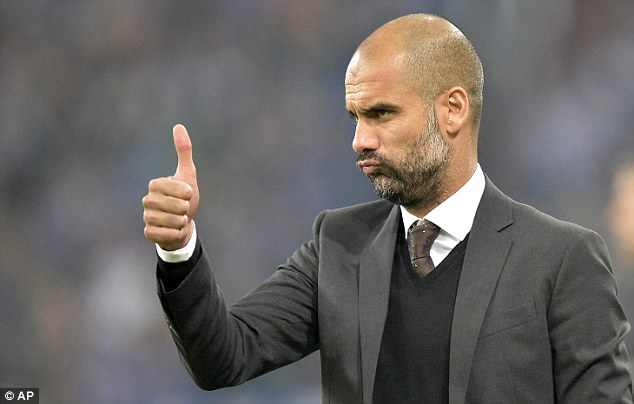One of the things I think a lot about is player development. Part of this is because my kids are right at the beginnings of their football journey (and my son especially, is football mad), and part of it is because I think it's an exceptionally important topic to understand in building a professional football team.
The dichotomy of this is fascinating. When out with my kids, I literally see the genesis of their skill set starting from nothing. When working professionally, I review players who are many zeroes away from the Top 1% in how good they are compared to the rest of the world.
Today I am going to outline coaching hacks I believe are huge keys to developing better players. Some of these are appropriate to the very young, and others need to wait until you start imprinting tactical knowledge on players. I think some of these are fairly well understood in other countries, but I rarely see the whole package together, nor have I seen it explained at a level I was happy with.
Some caveats before we get started:
- These are not validated research on my part. Much of my work is on statistics, and I only write about things I have researched well enough to be fairly certain are correct. This ain't that. Where there is validated research I am aware of, I will link to it. However, I will freely state these are my learned opinions on what is better and why.
- Most of the material in this chapter is not unique or original to me. Unfortunately I don't know where it started, and so can't appropriately credit it either. My apologies.
- Plenty of it might not even be new to you. If so, you are likely already doing a great job at developing players.
- Finally, this isn't comprehensive. While I think dribbling skills and first touch are incredibly important to teach players, I also think those are generally well emphasized in good programs.
Balance
What happens when you take a five-year-old out to the park and have them lift up their foot to trap a ball?
They fall over.
Then as they progress to being able to trap a ball, we start asking them to strike it.
When they try to strike it hard, they fall over some more.
Everything we do in football is based on balance.
Juggling?
Balance.
Striking a dead ball?
Balance.
Dribbling?
Balance.
First touch?
More balance.
Running? Cutting? Jumping?
Balance.
This particular element of skill and strength is woven through every single motion in the sport, and might be the one overarching thing that ties it all together.
I played five different sports when I was a kid in the U.S. How many of those explicitly taught me balance by itself?
Zero.
It wasn't until I started learning MMA late in my 20's that I learned balance could be taught, and not as part of doing activities inside of a sport.
Once I learned how to balance myself and apply the strength that came along with it, I suddenly became better at every sport I did.
Funny how that works.
Now some of you might suggest that the current methodology is fine.
Learning through doing is a tried and true methodology, and in many cases it just works.
I disagree.
What happens if you teach children balance first?
The short answer is that every single thing in the game of football becomes easier for them to accomplish. The long answer is that you produce better football players, because the ones you are now working with are more able to focus on explicit techniques and adjustments without the constant fear of falling over.
How do you teach balance?
This is one area where a tradition of thousands of years has probably got it right: kung fu. There are legions of internet resources on this not to mention books and videos.
In the martial arts I learned, we worked through stance progression on both feet. The progressions are crucial because that's where you build dynamic balance between the static movements. When initially learning the technique yourself in order to be able to teach it, it's probably useful to get together with a martial arts expert to learn properly, as much of this is fairly subtle.
But it's boring!
It is, a little. However, you can get kids doing these on their own with the right video/email nudge to the parents, and it literally only takes about 15 seconds per stance plus a slow transition between them to start to see the results. If you have attentive kids (do it post-warmup, after they have been running around a bit), it can be done in about 3 minutes.
Black belts in various martial arts can literally spend hours working through stances and body mastery, so the time progression here goes as far as you want it to. (But preferably at home and not during your incredibly valuable training time.)
Looking to create a little extra buy-in? Conveniently stance mastery is a key component of both jedi and ninja training. Let your kids know.
Here's another reason why I thing this topic is hugely important: Balance is absolutely crucial for smaller players.
A major problem we have in player development is that smaller players are constantly weeded out. Not for lack of skill - in fact, often they have better technical skills than their bigger counterparts - but generally for a lack of strength and "ability to compete."
Now picture the small players who are in professional football. Almost all of them have amazing balance. You often hear them described as having a "low center of gravity", which makes them difficult to knock off the ball, easier for them to tackle big players, and generally just annoying as hell to play against.
This is really just another way of saying they are short with great balance. Balance, and the strength that comes with it, is the key when it comes to enabling smaller players to compete with bigger ones. If you don't introduce this to your youngsters and give them a methodology to improve, you are failing them.
At the Pro Level
I was lucky enough to present at Science and Football this year with Grant Downie, Head of Performance at the Manchester City Academy. Grant is tremendously thoughtful, and the attention to detail he described City as paying to their academy was jaw-dropping. He told us that Manchester City have playgrounds for their academy kids, and those playgrounds intentionally feature plenty of balance-related elements. He also mentioned that their first team regularly does light wrestling, to learn to use balance when in contact with another person, which is especially useful when attacking and defending set pieces.
I was talking about this with Jim Pallotta, owner of Roma, in 2015 and he said they were doing balance tests in preseason and had a backup goalkeeper who kept falling over when asked to stand on one leg. Everyone in the room was shocked that something like this could still happen at the pro level. You know for a fact that if it is happening at Roma, it's probably happening everywhere.
Here's a blurry photo of Berndt Leno catching balls while kneeling on a balance ball as part of a warmup that I absolutely love.
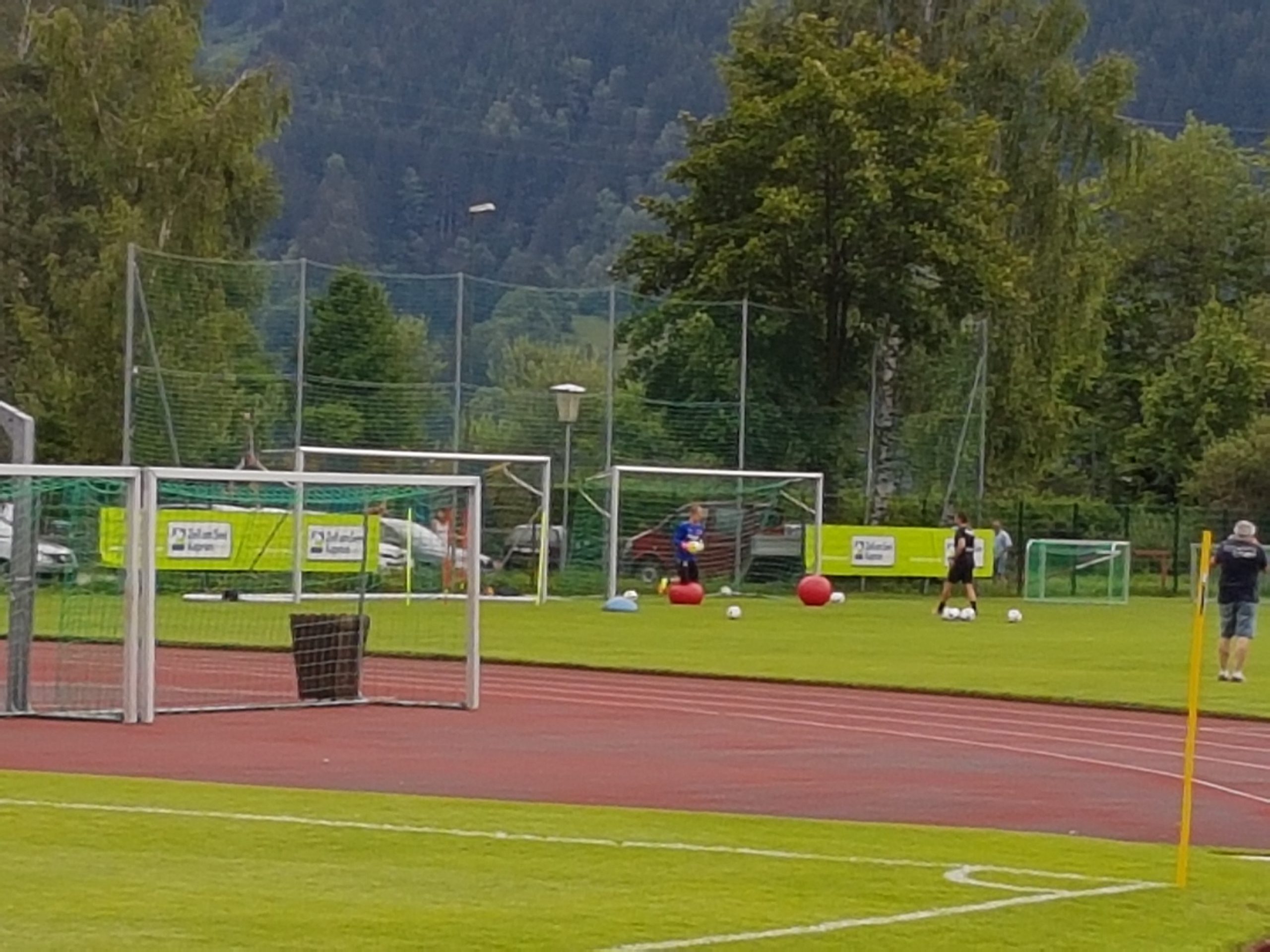
Balance and core strength is hugely important for GKs because they constantly find themselves in odd positions that they have to make explosive motions out of in order to make saves. Better balance also helps you become faster at making these dynamic motions, even when something has happened to mess up your initial positioning or footwork.
Also check out some of the sand pit work (around 1:35) in this video from the Ajax academy for some funky, creative ways to continue training balance at elite levels. Forwards are constantly getting battered by other players, and being able to continue executing while withstanding that sort of assault makes a huge difference in end product.
Two-Footedness
This is probably the most obvious hack on my list, but it happens far too infrequently. I think one of the major reasons is that is has to be trained young to take full effect, and professional academies rarely have access to children at this age. Because of that, the responsibility falls to parents and community coaches.
Having two good feet completely changes how a player can approach the game. It's hard to quantify, but it opens up the other half of their body, which in turn makes vastly more options available with every touch of the ball. More good options = more opportunity to succeed and maximizes good decision making ability.
Think of it from the perspective of the defender. If I know a player only has one useful foot, I can always key on that when trying to defend. It makes my life easier. On the other hand, if a player is running at me or likely to shoot, and he or she can use either foot with equal alacrity, my job is infinitely harder.
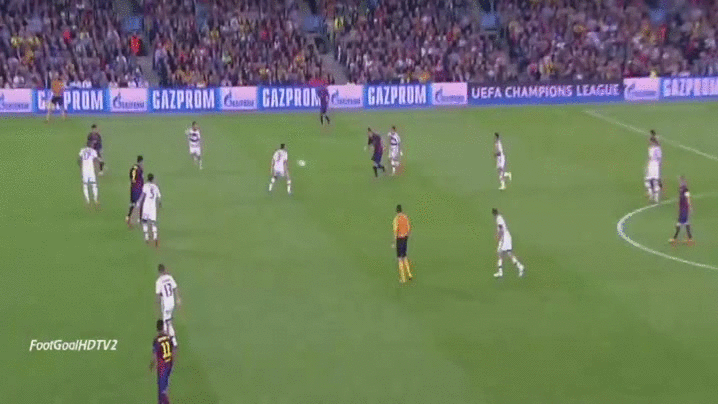
Having a second good foot also makes life easier for a player's teammates, since they suddenly have a much larger margin of error when passing to that player. I've run into two major difficulties in my own training of U7s and U8s in this area.
- You have to make the kids aware of the need to use both feet. It's also good to attach it to a player they really like and talk about how hard they worked to make sure both feet were good. (Santi Cazorla is my son's example.)
- You have to reinforce this need constantly.
Kids want to succeed.
As their dominant foot starts to get good, working with their weak foot feels like constant failure. Thus you have to talk about it in the same way as any other skill, but you have to mention it frequently, regularly, for years.
"Use the other foot! Now try it with your left! Pass it to the right, control with a touch, then shift it to your left to pass it back. Okay, now control with your left and shift to your right for the pass."
It is a long process, but... If you stick with it, you see your kids start to gain comfort. My son, who is an able U8 player but possibly nothing special, passes and shoots with both feet regularly during his games. He doesn't think about it either.
He's probably scored five goals over the last two years with his weak foot (his left), which never ceases to make me smile. We talk about why we train both feet fairly hard so that he understands it. One of the easiest paths to understanding was showing him how he could cut central much easier for better shots if he used his left foot as well as his right.
If you want to develop better footballers, you must impart the knowledge that this is important to your players, and find subtle, constant ways to bring it into training.
At the Pro Level
I was helping Flemming Pedersen (now technical director at Nordsjaelland) set up a Brentford B session last year and watching some players warm up. One guy, who was fairly well regarded, was only warming up with his right foot. I noticed and jokingly asked how many feet he had. "Two." At that age, if he's only warming up with one, the hope that a player can use both feet equally is probably dead. Start early. Reinforce it regularly. Constantly work it into training as a nudge.
Scanning
Scanning is the act of constantly looking beside and behind oneself on a football pitch. (Some coaches call this "shoulder checking", but it's a more comprehensive activity than that.)
To me, scanning is the single biggest skill that separates average from elite players.
It has also been heavily validated, so before we go too far, check out this presentation + paper from the Sloan conference back in 2013.
"The results show a clear positive relationship between visual exploratory behaviors (scanning) that are initiated before receiving the ball and performance with the ball. The best players explore more frequently than others and there is a positive relationship between exploratory behavior frequency and pass completion. The impact of exploratory behaviors is the largest for midfielders performing forward passes."
The first place I ever saw this highlighted was a video from AllasFCB about Xavi. I still get chills thinking about it, because in my mind it was truly this HOLY SHIT moment of new knowledge.
(See also: football epiphany.)
In the video, Allas shows just how often Xavi is looking around the pitch, without the ball. It is an insane number of times, like every other second for an entire game.
However, this activity is what powers Xavi's game. He had an almost otherworldly ability to see the pitch, find open men, find his own space, escape pressure, and complete impossible passes most players would never even see.
He could see these things because he was constantly looking around. When I first watched this video, my heart stopped.
I had been watching football for 15 years at that point, why had I never seen this?
It literally changes how you can see and play the game. One of my all-time favorite examples of this came during a Bayern Munich match from last season. Watch Xabi's head look to his left just as the right back receives the ball.
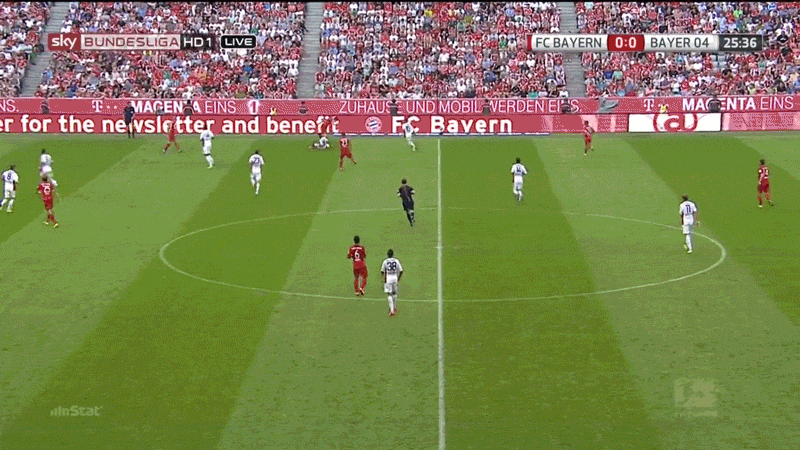
As part of his scanning, he spots Costa in space with only a fullback near him. It's an amazing pass, but that pass is created because his scanning made it possible.
Here's the thing - scanning is important everywhere on the pitch. Forwards need it to see who is around them, whether they can turn, where the space is, where they should run, etc. Midfielders need it for absolutely everything, since they are surrounded by opponents at almost all times.
Defenders need it to know not only where their nearest opponent is, but where their helping teammates are, where additional runners may be, and as you see above, where their potential passing outlets are once they recover the ball.
You want to teach your players to play one step ahead of the opponent?
Teach them to scan.
How best to train scanning?
I don't know.
This was high on my list of things I wanted to learn when visiting elite academies, but I never got to make that trip. I have some ideas on how to go about it, but have done zero work on best practice.
I asked a high level English coach how he would go about training it once and got the following answer:
"I learned to look around when they threw me into training with the big boys, because if I didn't, they'd kick holes in me. Teaches you right quick, that does."
We may have some issues with pedagogy in this country. Please leave links in the comments if you have information on how to train this at different levels, and I'll review them and gradually move the best of them up here as recommendations.
Cover Shadows
In my head, this is the inverse of scanning for the defensive side of the ball. It requires scanning to do well, but understanding cover shadows will help players dramatically limit passing options for opponents. Think of the ball as a light source. Bodies of defenders are solid, and they create shadows behind themselves.
Here's an image from Rene Maric that clearly illustrates the concept, and the grey shaded area are covering shadows for Iniesta and Xavi.
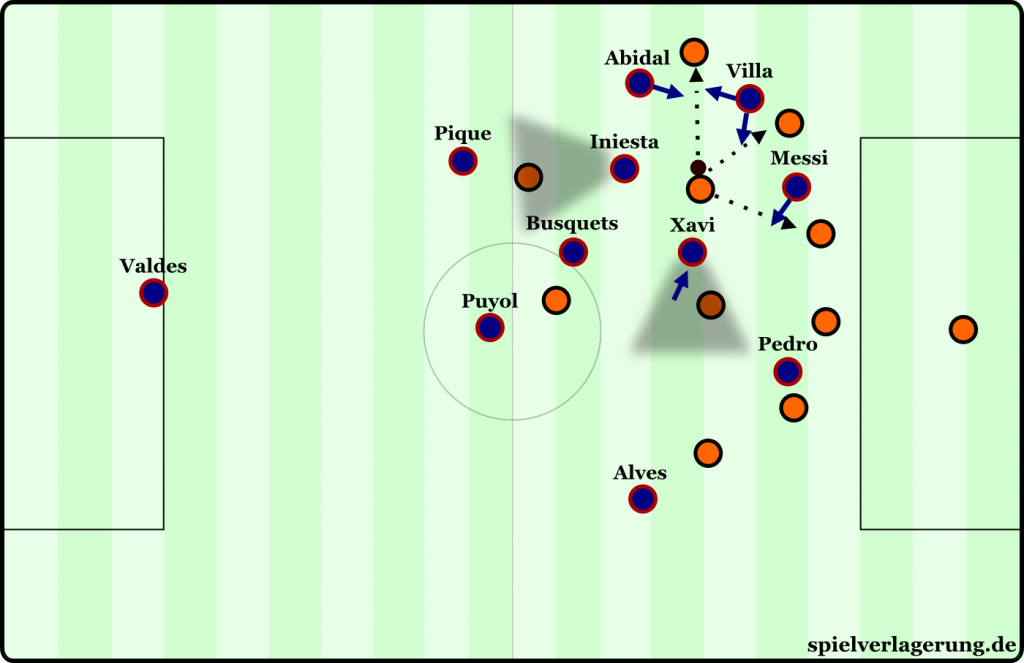
Why does this matter? Because it is a key to defending, particularly to pressing defense. It allows a player to not only press the ball, but also to limit a passing option at the same time. And it is a concept your attackers need to understand in order to work through a press from their opponents. Unclear? Check this out. Watch Aubameyang's sequence of presses here and in particular, look at how he cuts off a passing angle with a curved run each time.
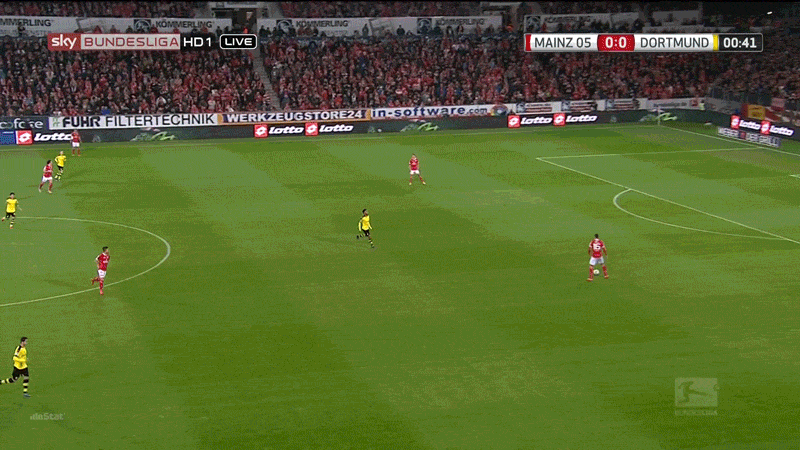
Then notice the creep (or sprint) on the other Dortmund defenders as they move forward and further cut off lanes like some sort of pressing python, strangling possession.
The result is a long pass into the distance, and likely Dortmund regaining the ball. I also like the explanations from Spielverlagerung about Atletico's press, which has a different flavour than Tuchel's, but the underlying concepts are similar.
That piece is crazy long, but example 1 is enough to get a sense of what I mean.
How do you train it?
It goes hand in hand with scanning and pressing. How do you train elite level pressing? What are the sessions?
What does the knowledge progression look like?
Sadly, I once again don't know.
As I mentioned in my How Coaches Learn article, coaching knowledge is very much an apprenticeship, and I have not been able to learn how to teach this to players from experts yet. That doesn't change the importance of the skill with regard to player development. It just means my ability to convey further knowledge to you is currently limited. Think of the following things slotting into place for your players:
- Scan the whole pitch in attack.
- Scan the whole pitch in defense.
- Work covering shadows aggressively.
- Form Voltron.
That's almost how it works. First you make one phase of the game far easier for yourself. Then you make the next major phase easier as well, and you make your transitions better in the process. Finally, you make attacks for the opponent far more difficult. The result should be a massive improvement on a possession by possession basis.
Wrap-up
To me, the four elements discussed above are the fundamental building blocks for developing better, smarter players. I don't know how to train the last two well, because they are specialized knowledge that I have yet to unlock, but I am absolutely certain of their value to modern footballers. Thanks for listening.
--Ted Knutson @mixedknuts
Post Script
This is another chapter in a book I have gradually been developing over the last year. It touches on all sorts of topics, but the main purpose is to explain how I view the game of football and why I think the way that I do.
I don't approach the game from the standpoint of someone who played - that wasn't an avenue that was available to me where I grew up.
Instead I approach the game from a standpoint of examining what matters, how do we prove that, and how do we apply these lessons to teams on the pitch? Currently finished chapters are linked below (and are all free), so have a poke around if you are interested in more.
Explaining and Training Shot Quality The Future of Football How Do Coaches Learn? The Death of Traditional Scouting New Tech Marcus Rashford and Young Player Development
